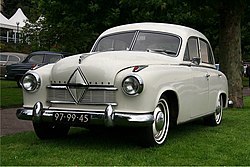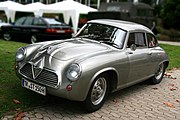Borgward Hansa 1500
| Borgward | |
|---|---|
|
Borgward Hansa 1800 (1952–1954)
|
|
| Hansa 1500/1800 | |
| Production period: | 1949-1954 |
| Class : | Middle class |
| Body versions : | Sedan , station wagon , convertible |
| Engines: |
Otto engines : 1.5–1.8 liters (35–44 kW) Diesel engine : 1.8 liters (31 kW) |
| Length: | 4450 mm |
| Width: | 1620 mm |
| Height: | 1560 mm |
| Wheelbase : | 2600 mm |
| Empty weight : | 1120-1245 kg |
| successor | Borgward Isabella |
The Borgward Hansa 1500 is a mid-range car from Carl FW Borgward GmbH in Bremen-Sebaldsbrück and was the first German car redesign after the Second World War . The first car rolled off the assembly line on October 13, 1949.
history
In March 1949, Borgward presented the car at the 19th Geneva Motor Show . The Hansa in 1500 was mainly the first German series-produced saloon after the war with pontoon body and turn signals instead of the formerly standard Winker as direction indicators .
In August 1950 Borgward set twelve international records with a racing car based on the Hansa 1500 in Montlhéry, France . The car was designed by the engineering office INKA (Ingenieurs-Konstruktions-Arbeitsgemeinschaft) consisting of a group of former Auto Union technicians and engineers led by August Momberger . Momberger built an aerodynamic streamlined fairing made of aluminum and Karl-Ludwig Brandt increased the engine output to 66 hp. The so-called INKA car was driven by August Momberger, Adolf Brudes , Heinz Meier and Karl-Heinz Schäufele.
Engine, transmission and chassis
The four-cylinder in-line engine of the Hansa 1500 had an output of 48 hp (35 kW) at 4000 rpm at the start of production. With a bore of 72 mm and a stroke of 92 mm, the displacement was 1498 cm³. The hanging valves were operated by a side camshaft via push rods and rocker arms ( OHV valve control ).
From the end of 1950, the engine developed 52 HP (38 kW) at 4200 rpm with the same displacement. The sedan's top speed was 120 to 125 km / h. In the sports convertible, there was an engine variant that developed 66 hp (49 kW) and allowed a top speed of around 150 km / h. In 1953, this car was even available with the 80 hp engine from the Borgward racing car.
The Hansa 1500 initially had a four-speed gearbox with center shift (also called "stick shift") and, from the end of 1950, a steering wheel shift . A propeller shaft were rear wheels driven .
The wheels of the Hansa 1500 are individually suspended : at the front on upper wishbones and lower transverse leaf spring, at the rear on a pendulum axle with transverse leaf spring that is guided by links . The lever shock absorbers of the first series were replaced by telescopic shock absorbers in late 1950 . The foot brake acts hydraulically on all four wheels, the hand brake mechanically on the rear wheels.
body
The Hansa 1500 has a two- or four-door all-steel body, which is built on a central tubular frame with cross members and floor pan, forked at the front and rear. The fenders are integrated into the side panels, so that despite the relatively small external width (1620 mm), the interior space is larger than that of the competing models from Mercedes-Benz and Opel. In the press it was said: “The pontoon body has the advantage that almost the entire width of the body is used for the interior, so that there is room for 6 people comfortably. It has very smooth, easy-to-produce outer surfaces and can be designed with a streamlined design. ” The doors are hinged at the front, the trunk is accessible from the outside; the bonnet is folded up from the side, left or right as required.
An eye-catcher inside is the white steering wheel with three spokes, each made of four thin metal rods (similar to the steering wheel on the first Porsche models). The Hansa 1500 with steering wheel gearshift has a continuous bench seat at the front as well as at the rear so that three people can sit next to each other. In the first version with stick shifting, however, there were two individual seats at the front, as the approximately 70 cm long curved shift stick and the voluminous transmission tunnel did not allow a third place.
In addition to the two- and four-door sedans, the Hansa 1500 was available as a three-door station wagon, a two-door sports coupé (prototype), a five-seat convertible with two doors and a two-seat sports convertible with a wheelbase shortened to 2400 mm and a length of 4165 mm. Both convertibles were built by the Hebmüller bodywork plant in Wülfrath until May 1952 .
Hansa 1800
1952 received the Borgward Hansa a 1.8-liter engine (1758 cm³) with 60 HP (44 kW) at 4200 / min. The cylinder bore was increased to 78 mm, the stroke remained at 92 mm. The three-speed gearbox initially built into this engine was replaced in March 1953 by a four-speed gearbox synchronized between third and fourth gear . An automatic transmission was also available. The sedan reached a top speed of 136 km / h.
Together with the larger engine, the car received the type designation Hansa 1800 . Externally, the new model was recognizable by elongated indicators on the front fenders (on the 1500 under the headlights), trim strips under the side windows and the Borgward rhombus on the hubcaps.
In addition to the sedan, station wagons, convertibles and sports convertibles continued to be offered.
In 1953 the Hansa 1800 appeared with a four-cylinder diesel engine. With the same displacement as the gasoline engine, the diesel developed 42 hp (31 kW) at 3400 rpm; Maximum speed according to the factory specification 100 km / h. After the 260 D and 170 D from Mercedes-Benz and the record from Hanomag, the Hansa 1800 was the fourth German passenger car with a diesel engine.
Technical data of the Borgward Hansa 1800 Diesel
| Borgward Hansa 1800 Diesel (1953) | |
| Engine: | Four-cylinder in-line engine (installed behind the front axle) |
| Displacement : | 1758 cc |
| Bore × stroke: | 78 mm × 92 mm |
| Compression: | 19.8: 1 |
| Performance at 1 / min: | 42 hp (31 kW) at 3400 |
| Maximum torque : | 10.4 mkp (102 Nm) at 2200 rpm |
| Valve control: | side camshaft, overhead valves |
| Mixture preparation: | Swirl chamber injection |
| Cooling: | Water with pump and fan |
| Transmission: | 4-speed gearbox with steering wheel gearshift (rear wheel drive) |
| Brakes: | Hydraulically operated drum brakes |
| Front suspension: | triangular wishbones above, transverse leaf springs below, telescopic shock absorbers |
| Rear suspension: | Pendulum axle with trailing arms and transverse leaf spring, telescopic shock absorber |
| Body: | All-steel body on a central tubular frame |
| Wheelbase : | 2600 mm |
| Track width front / rear: | 1250/1300 mm |
| Wheel size: | 6.40-15 |
| Dimensions L × W × H: | 4450 mm × 1620 mm × 1560 mm |
| Turning diameter: | approx. 11 m |
| Empty weight (without driver) two / four doors: | approx. 1210 kg / approx. 1245 kg |
| Standard fuel consumption: | approx. 6.5 l / 100 km |
| Test consumption: | approx. 8.5–9 l / 100 km |
| Top speed: | 100 km / h (106 km / h in the test) |
| Limousine price: | 9,950.00 DM (two-door) - 10,450.00 DM (four-door) |
The information is taken from a test report by Helmut Werner Bönsch in Auto und Motorrad-Welt from March 20, 1953.
literature
- Heinrich Völker: Silver Arrows from Bremen . Racing sports car from the Borgward works. Peter Kurz, Bremen 2004, ISBN 3-927485-43-8 .
Web links
Individual evidence
- ^ Georg Schmidt: Borgward - Carl FW Borgward and his cars. Motorbuchverlag, Stuttgart 1986, ISBN 3-87943-679-7 .
- ↑ a b c d Peter short: Borgward typology. Delius Klasing Verlag, Bielefeld 2009, ISBN 978-3-7688-2599-3 .
- ↑ a b c d Peter short: Carl FW Borgward automobile works. Verlag Peter Kurz, Bremen 2001, ISBN 3-9806977-3-8 .
- ↑ Völker (2004), pp. 5–10
- ^ Lena Siep: Borgward press kit. (PDF) (No longer available online.) Www.borgward.com, March 3, 2015, archived from the original on May 25, 2015 ; Retrieved May 25, 2015 . Info: The archive link was inserted automatically and has not yet been checked. Please check the original and archive link according to the instructions and then remove this notice.
- ↑ a b c Auto und Motorrad-Welt, No. 6, March 20, 1953.







